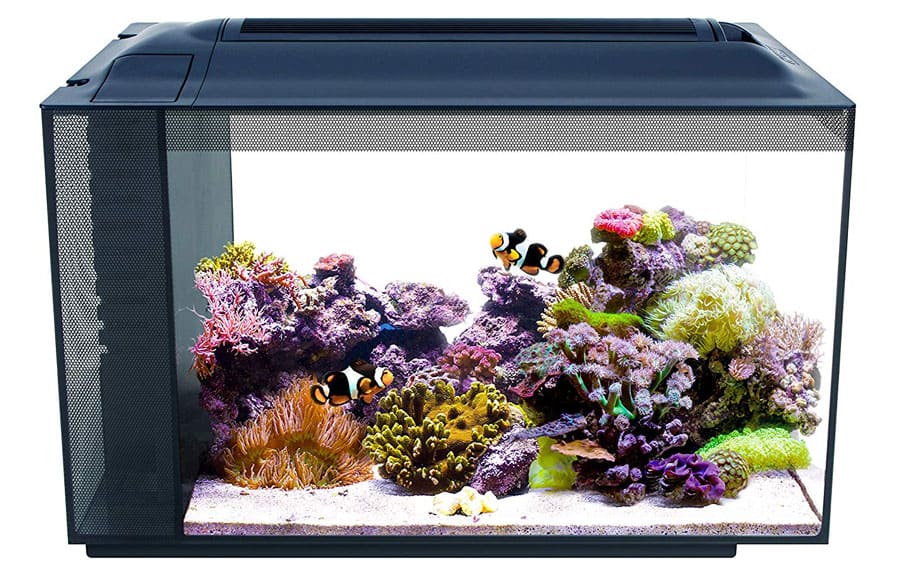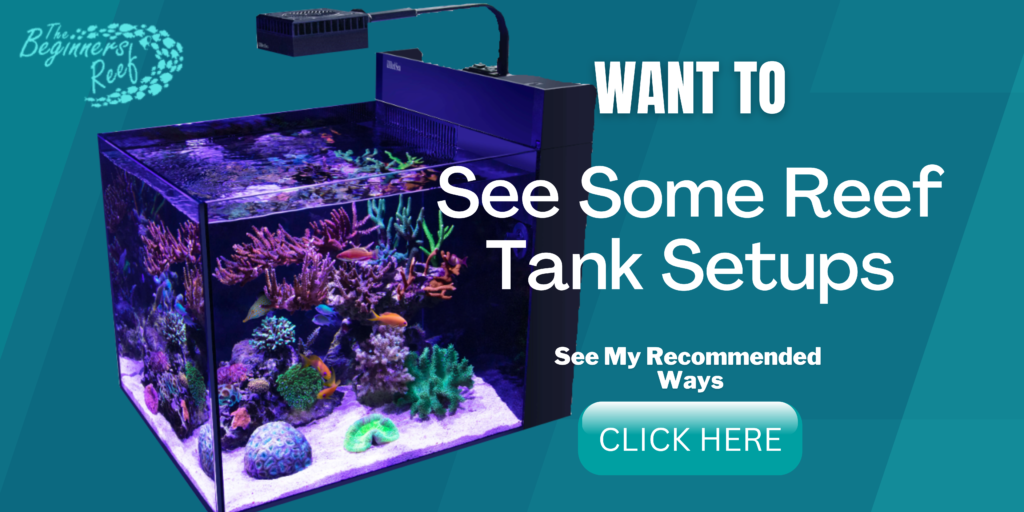Buying your first saltwater aquarium is a really exciting time and hopefully, it will be a time you will remember forever! I still remember picking up my first reef tank! I was like a kid in a candy store!!
With so many types, shapes and sizes of the aquarium it can be difficult to know which one is right for you and it is going to take a little bit of Q&A to figure that out, but that is where this article will hopefully help.
In general, 40-75 gallon aquariums are the perfect size for a first reef tank. They are a good size to create a stunning aquarium, but not too large to stock and maintain. All-In-One aquariums are popular as they come with everything built into the tank kit and are very easy to set up & afford.
Many people may argue that these tanks are too small but as a first-time reefer you want to be smart with your money and give yourself the best learning experience without causing financial or time distress.
Once you have gained some experience and you are sure this hobby is for you then an upgrade after a few years will be a much smarter option. By then you will understand exactly what fish, coral, and aquarium you would like.
You would never try fishing for sharks by going out a buying a boat, trailer and thousands of dollars of gear. You go and try a charter first and see how you like it. This hobby is just the same.
With today’s technology and the understanding of what you need to do you can successfully keep smaller reef tanks with ease. Don’t take my word for it, go check out the forums at Nano-Reef.com!
What Things Are To Consider When Buying Your First Reef Tank?
Now before you get to your fish store or start looking through the online vendors there are a few things you need to go through and answer that will help steer you to your perfect first tank:
- Volume
- Initial Budget
- Monthly Budget
- Installation Location
- Planning to Move House
- Time
Let’s look at each one in more detail…
Volume
Volume is the total water volume your aquarium system holds. You generally want to get the biggest volume you can afford and fit in your desired location.
The biggest reason you want to get the biggest you can is to aid in water stability. With a reef tank, the stability in all of your water parameters will dictate how well your tank will run and grow.
The more volume your system has, the longer it takes for any parameter to swing one way or another. Take temperature for instance – A small 20 gallon tank can heat up and cool down rapidly in homes that get hot during the summer months. This causes rapid swings in temperature.
Now place a 75 gallon aquarium in the same room and it will take far longer to heat up and cool down creating a more gradual change rather than rapid spikes.
This is the case for all water parameters – More volume = More work needs to be done by external influences to affect it.
An aquarium with a sump is a great way to increase water volume for a given floor footprint. Adding a 20 gallon sump into the stand can increase a 60 gallon aquariums volume by 1/3.
Initial Budget
There is no question that setting up your first reef tank can get expensive real quick if you have to buy everything brand new. Here are a few things you WILL need straight away:
- Tank & possibly stand, canopy
- Reef-Capable Light
- Live/Dry Rock
- Sand
- Heater
- Protein Skimmer
- Filter Media
- Salt
- Refractometer
- Test Kits
- Thermometer
- Wavemaker/Powerhead
- Nets
- Food
- Livestock
- Algae Magnet
- Toothbrush or Algae Scrubber
- Sand Vacuum
- Containers for Water Changes
- Measuring Cup/Jugs
- Turkey Baster
- Towels
In addition to the above items, these are very popular first purchases to really help keep your aquarium stable:
- Automatic Top Off System
- RO/DI Water filter
- Small Quarantine Setup
Now, this may seem overwhelming at first but these are just the basics you will need to get your aquarium running. Most of these items will cost roughly the same no matter what size of aquarium you get but some are going to really increase in price when you increase the size of the aquarium! Protein Skimmer, Lights & Rock will increase the most.
Here is a free downloadable guide to help you check off all the equipment you may need to get started:
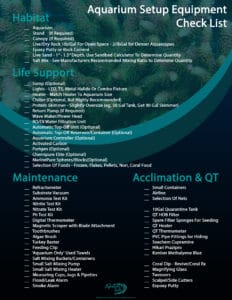
Click Here To Download The Free PDF Guide
Monthly Budget
Once you have your aquarium setup you are going to have ongoing monthly costs that you will also have to take into account.
Consumables like food, salt, and test kits are the most common costs. These are items that will last you many months, but if you budget each month then when you have to buy another bucket of salt, for instance, you will have the money for it.
Many tanks fail because life throws unexpected curve balls at you, then that bucket of salt you need for your next water change does not get purchased and your water change routine starts to lapse.
The larger the aquarium, the more consumables like salt you will use. Not only that, but you will want to stock the aquarium and coral and fish are expensive. Your first 1-2 years will need a healthy monthly budget to get it filled, especially if you have a +75 gallon tank!
Once you have set up a reef tank, the ongoing commitment is what will guarantee its success or failure.
For more in-depth information on monthly running costs please see our article in the ‘Further Reading’ section at the end of this article.
Installation Location
This is usually one of the biggest factors on what size tank you get. Where can you place the aquarium? – Is the tank going to be small and can sit on your kitchen counter or office desk, do you have a perfect 4ft recess in your living room? Are you creating a room divider?
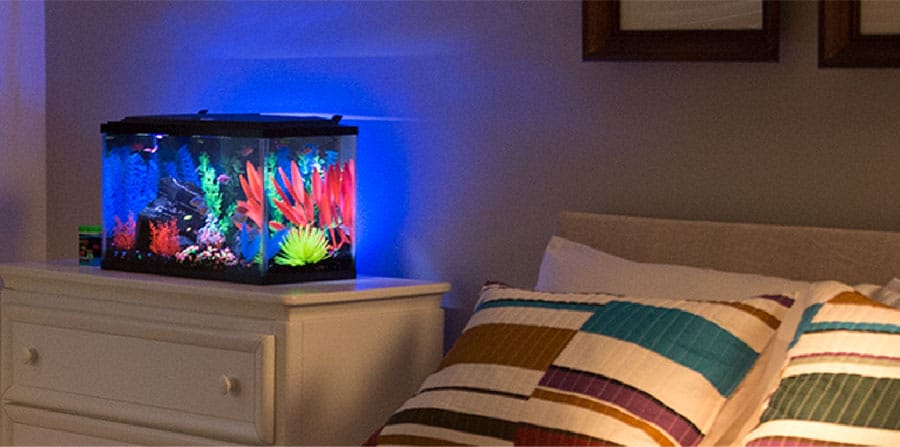
There are also many other things to consider when placing an aquarium. Can the floor support the weight of a 100 gallon aquarium (860lbs for the water alone)? Is it next to a well-used door that is going to be constantly banging? Will it be exposed to -40°F every time you open the front door in winter?
For some of you, the perfect location may have sparked the thoughts that began your journey into saltwater aquariums, but there are just a few things you need to think about that may not be obvious. Just one of them could be a game-changer for your planned location.
Some things to consider are:
- Is it in the best viewing location, or stuck in a hallway with no one to view it?
- Is it accessible for maintenance? Deep aquariums can be tough to work on without side access.
- Will it get direct sunlight? Possible algae issues.
- Draughts and HVAC vents. Will these cause temperature control issues?
- TV and stereo speakers – Are these close by to cause fish stress from constant vibrations?
- Are there sufficient electrical outlets close by? Overloading electrical outlets can lead to a fire.
For more detailed info on these points please check out the link to our Aquarium Location article in the ‘Further Reading’ section at the end of this article.
Planning to Move House
Are you planning to move house in the next few years? Are you on a 2 year lease for your rental? Moving a 20 gallon nano aquarium is a pretty straightforward process. However, moving a 75 gallon reef tank that is full of coral, fish, and inverts is going to take a day just by itself, let alone moving the rest of your house!
If you are planning a move in a few years, then I would suggest you start with a small nano aquarium then use the move to plan your upgrade. That way you can also purchase an aquarium to perfectly suit your new home.
The aquarium you have now may have absolutely nowhere to go in your new home! This is a rare scenario but it is one I have come across when moving an aquarium for a client. It was then a mad panic to buy a whole new aquarium, stand and sump! That was a long and stressful day!
Time
Just like any pet, a saltwater aquarium is a commitment and time is part of that. Daily and weekly time must be dedicated to the upkeep and maintenance of your aquarium to ensure the inhabitants live in pristine conditions.
Without having a regular time slot to attend to the tank it can soon be on a downhill trajectory that can cause you a lot of stress, extra time and money to fix.
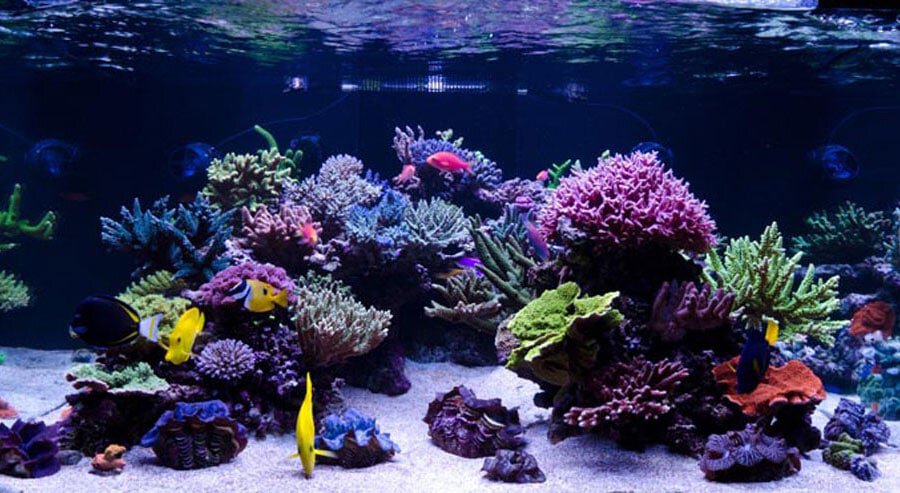
For me, every Tuesday night after the kids have gone to bed is my tank night. This is when I do my water parameter tests, maintenance, water change, and general inspections to ensure my reef stays the best it can be.
I can tell you from experience it is a lot easier to scrub off a light dusting of algae off the pumps, overflow and tank seams than it is to remove hard, encrusted concrete that has been left for several months!
No matter the size of the aquarium, your time that you need to dedicate to it will not vary much if you stay under the 100 gallon range.
Are There Different Types of Saltwater Aquarium?
Now that you have seen some of the things to consider when buying an aquarium this leaves the type of aquarium. There are many styles to pick from and all have varying price ranges.
The main thing to consider is that as you go up in gallonage, the price and size of the equipment to run it also increases. Some of the ‘Plug&Play’ systems from the manufacturers may seem to have a hefty price tag, but when you sit down and total up all the equipment that you may otherwise need, you can see there might not be much difference in the two totals.
Standard Aquariums
Standard aquariums are an off the shelf aquarium that can be bought in most pet stores and be used for freshwater, saltwater, reptiles, and rodents.
These are by far the cheapest aquariums but you can be very limited to the equipment you can fit and run on them. Hang-On-Back filtration and canister filters are the most popular form of filtration used with this type of aquarium.
There are many successful saltwater aquariums ran this way but they do have some challenges in terms of maintenance, space to fit equipment and the biggest issue I find with these tanks is that all the equipment is visible which takes away the natural beauty of the reef you are trying to create.
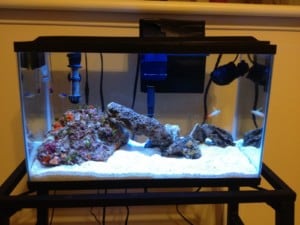
40 Gallon Breeder Aquariums are a very popular standard-sized aquarium as they offer a nice volume and great dimensions for a reef tank – 36″ Long x 18″ Wide x 16″ Deep.
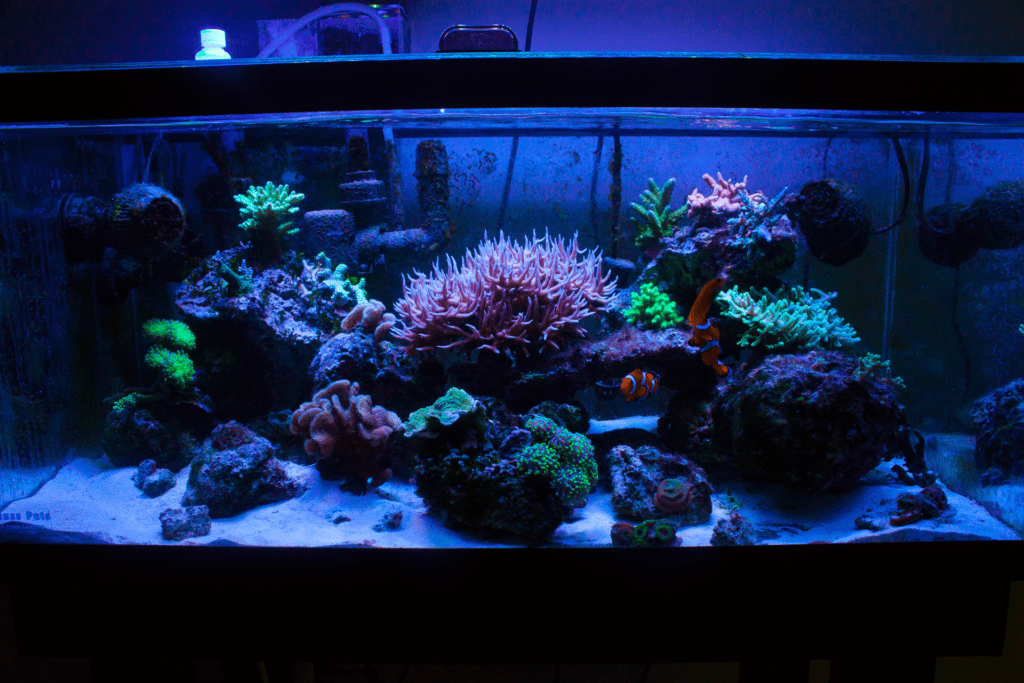
All-In-One Aquariums
These are great for a first aquarium as they have all the filtration built into it and the can come with matching stands if required. They are usually in the smaller gallonage range for aquariums which makes them great for a beginner.
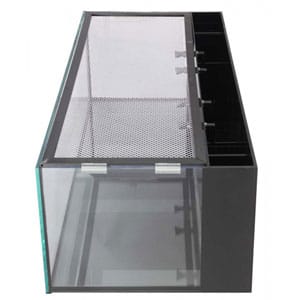
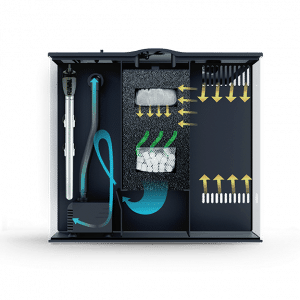
There are many great AIO aquariums available all with varying equipment included. There are many optional upgrades available for many of the AIO aquariums making it extremely easy to increase the efficiency of the aquarium while keeping all the equipment hidden away in the filtration area.
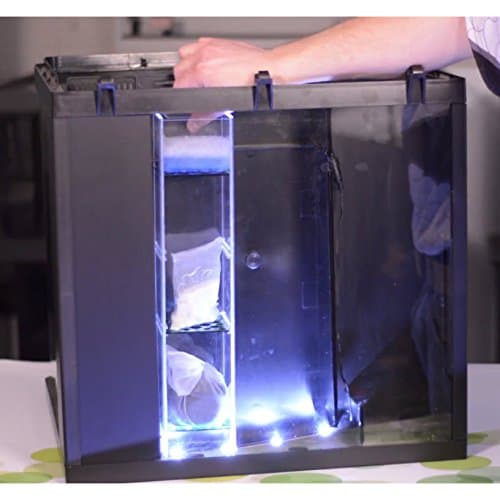
One of the most popular upgrades is a Media Rack from InTank. These devices allow for easy access to filtration media for quick replacement in a vast range of AIO aquariums.
Each rack is specifically designed to fit the designated aquarium.
You can find more information on them
Here at Amazon.com
You Can Find Out More Information About All-In-One Aquariums Here:
What Is An All-In-One (AIO) Aquarium?
Aquariums With Sumps
By far the most common type of aquarium setup in our hobby. There are so many types and sizes of both aquarium and sumps, including some Plug&Play kits from the popular manufacturers.
You may hear these types of aquariums referred to as ‘Drilled’ referring to the glass being drilled for pipes to be installed. An overflow or surface skimmer is required to maintain the water level at a set height.
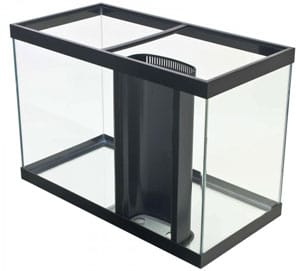
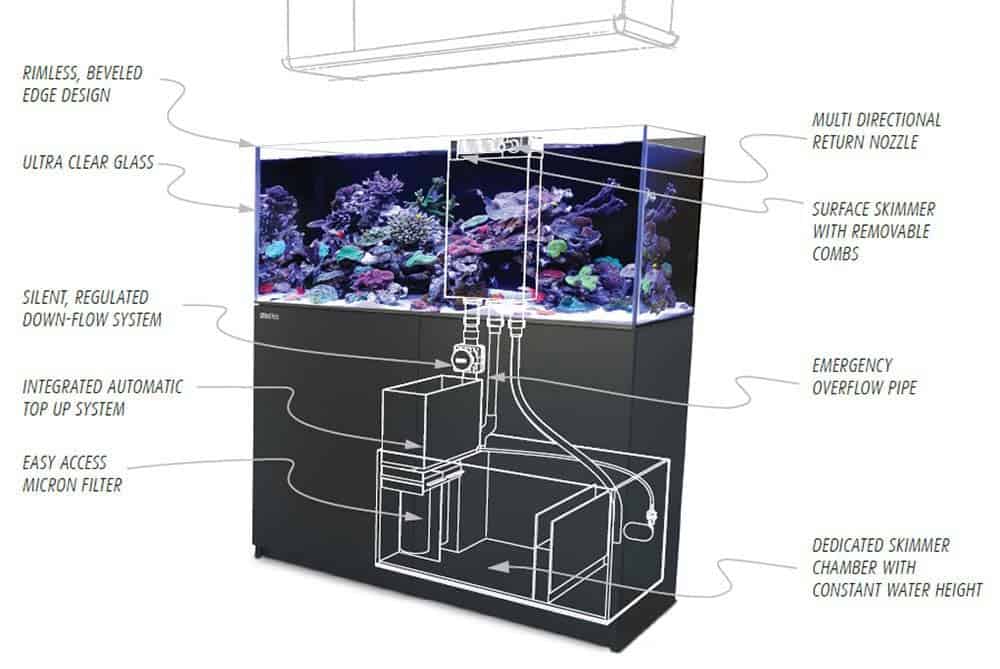
Sumps are usually installed in the cabinet below the aquarium or can be installed in a separate filtration room and piped to the aquarium.
This is how I have my aquarium installed. The tank is in the living room, with all my sump and filtration below in the basement.
You can have aquariums with the plumbing or overflow installed internally or externally to suit your preference.
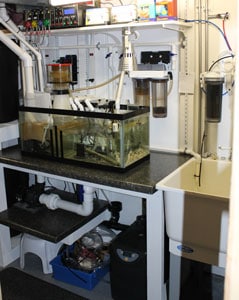
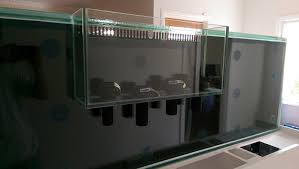
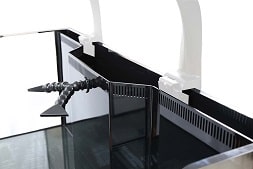
Because of the many options/combinations available from so many manufacturers, this can be one of the cheapest types of aquarium to install, but it requires more design work on your part.
You Can Find Out More About Tank & Sump setups Here:
What is a Reef Ready Aquarium?
Cube Aquariums
Cube aquariums are aquariums that are the same dimensions on all sides to form a cube. These can make incredible aquariums for the right location as they can provide great depth to craft some beautiful aquascapes.
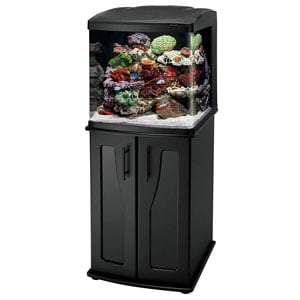
Cube aquariums can come in a variety of types from AIO, internal or external overflows, as part of a Plug&Play kit or be sold as separate parts so you can design a system to match your requirements.
One great feature of cube aquariums is that you can have them custom made with a center overflow and with some clever plumbing you can have a reef tank sitting in the middle of your room with very minimal equipment visible.
This is not a common aquarium, especially for a beginner but if your home and budget would fit this type of aquarium then you can have a show stopper tank built for you!
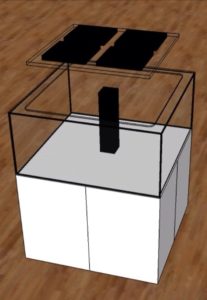
Drop Off Aquariums
These are a new trend that has materialized within our hobby and they create a very unique looking aquarium. They are modeled on the edge of a coral reef where they drop off into the abyss.
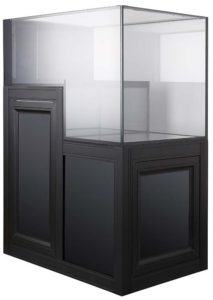
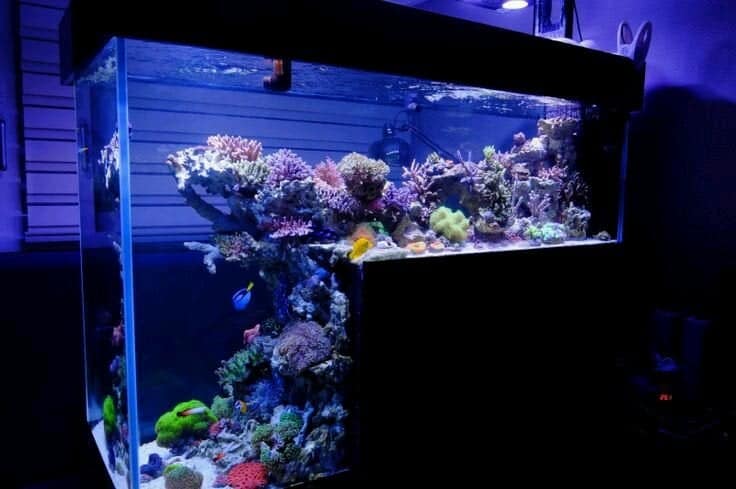
These aquariums usually come with an internal overflow and room for a sump in the cabinet below. Many people like to use these aquariums as they can fit perfectly next to a chair or at the end of a couch and make viewing them as comfortable as you can get!
Saltwater Aquarium Setup Examples
Selecting the aquarium is just one part of the process but then it can be really daunting to figure out what equipment is needed to run the tank. To help you with this I created a series of Setup Guides that list all the essential equipment and costs for many different sizes and styles of aquariums.
You can find the guides by clicking the banner below:
To Finish
Deciding on the type and size of aquarium for your first reef tank is one of the most exciting parts of your journey. By being able to think about every point mentioned in this article you should be able to find the perfect solution for your home or office and ensure you will have the time and finance to ensure its long term success.
Be aware though that this hobby is addictive and every aquarist starts to think about their next tank and 99% of the time its a bigger tank!
The best size aquarium for you is a combination of budget, time availability, location and the style of aquarium. When done right your aquarium will become a piece of art in your home that will be cherished by all for many years to come.
Further Reading
If you found this article helpful may I suggest a few of our other articles which may help you further:

